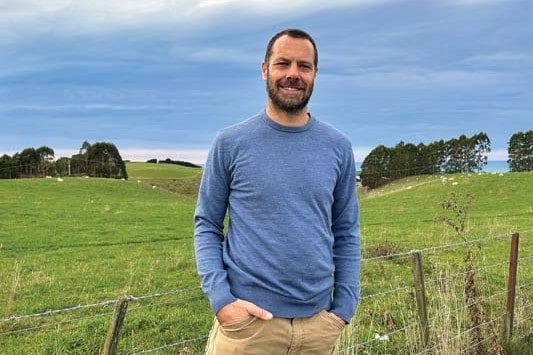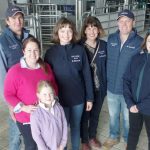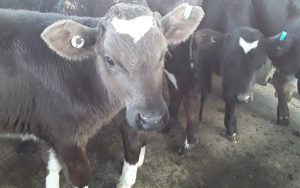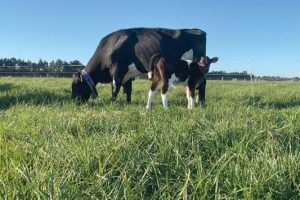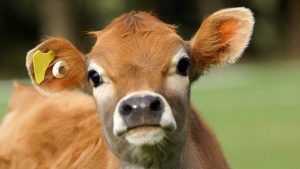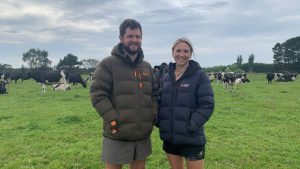
A scientist with an agricultural background believes he has an answer to the glut of bobby calves.
Two million non-replacement calves are killed at four days of age in New Zealand each year – a solution needs to be found to that.
Kakanui man Daniel Carson has a solution, and it’s miti.
Daniel grew up in Southland, studied at Otago University, and worked in sales, and business development for technology companies, before taking up the opportunity to stop travelling for work, start a family and help farm a 20-hectare piece of land. So that’s what he did.
“We started with Friesian bulls, or four-day old calves, and we were all about management through measurement.
“So, because of my technology background, I just measured everything, and quickly read a lot of material… By the time my farming career at that point came to an end, we were farming over 2000ha and wintering 7000 stock units, and I really wanted to do something positive for an industry I was passionate about.”
In 2020, when the country went into lockdown with the Covid-19 pandemic, he pitched to the Government, who had put out a call out for suggestions around “Projects of National Significance”.
“I said that we needed to make a system of software and sensors to capture environmental and agricultural data, ultimately at scale, that would then allow us to use machine learning, and AI (artificial intelligence) to export our agricultural IP (intellectual property), to the world. And essentially be able to offer our know-how to countries, and create opportunities for smaller and remote Maori landholdings, through automation, that type of carry on,” he said.
“They came back saying, ‘that sounds good, we encourage you to keep going, but it’s not going to be our project of national significance’. Which, you know, I expected.”
It is an idea he still believes in, but couldn’t afford to follow through on – he lacked the connections and the finances – and so on to the next idea.
The next concept is a value-add food product using a source he has experience with and is passionate about – dairy beef – mixed with another passion, science and data.
“I’d raised a whole lot of bulls in my previous occupation, and understood, essentially, all the data for those animals is recorded from birth through to death. They’re regularly weighed, and they grow very fast – their feed conversion efficiency is awesome, and it’s a major issue for the dairy industry.
“I just looked at it from, I suppose, a different perspective from what everyone else is doing, and from what they are traditionally used for, which is manufacturing (minced) beef – and thought well, why don’t we make a new product that doesn’t exist from it, that represents New Zealand, and what I see as the best for New Zealand and the future of New Zealand.”
For a long time he had wondered why the country did not produce its own version of a dried meat product, such as a beef jerky or biltong.
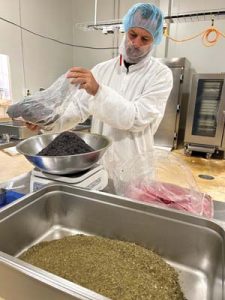
“I thought well, why don’t I do that – and why don’t I incorporate a whole lot of other ingredients unique to New Zealand.”
The easiest way he saw was to start with a manufacturing beef base, which allows other ingredients to be mixed in.
Minced beef also means the end product is easier to chew, making it more viable for a wider group of consumers – such as children and the elderly.
“I looked at what exists currently, and I’ve always believed that meat was a nutrient-dense health food. I thought that there was a whole lot of science coming to support that, and I was like, ‘well, how do we enhance that story, and not essentially take away from it, by filling it with salt preservatives, like other dried meat products are’.”
One prerequisite was the product needed to have shelf-life, so it wasn’t a “price taker”.
Friends at Staveley, who own Southern Alps Honey in Canterbury, harvest honeydew from the black beech forests. Daniel’s research revealed honey has been used as a natural preservative for thousands of years, and so he investigated that option further.
“It’s got some unique properties, so I decided to use that as our natural preservative, but also as a prebiotic and all the natural health benefits that go with it.”
And from there, he started networking. “The first thing I did – and it was really beneficial, there was a Food, Fibre and Agritech Challenge, which is actually running again this year.“You go through a series of courses around setting up a business, and you’re assigned a mentor and that was really good, but it also made me realise that the flavour of the day was plant-based meats, it was technology, it wasn’t meat foods.”
After that, he applied for funding with the Agricultural and Marketing Research and Development Trust (AgMardt) to see if he could get the shelf-life ultimately, and how the honey would mix with the beef.
Success with that application gave Daniel the confidence to engage with AgResearch for help around meat processing issues.
It is currently inefficient to process the 12-month animal, as all the processing companies he has spoken to indicate the costs involved are similar to those for a full-sized animal.
“So there was no issue at farm level. There was no issue with supply of these animals. The issue was with the meat processors – they ultimately want to charge you the same amount for half the amount of beef, which ends up making the raw material very expensive.”
AgResearch suggested Daniel apply for funding via the Ministry of Primary Industries (MPI) with their support.
“I did that, and was fortunate to be given enough funding to take this through to commercialisation trials.”
Seeking flavour
While production trials had already begun, the initial samples were very dry, and lacking in flavour. After some trial and error he came across a food technologist who supercharged the process and since then, a number of different samples have been produced, containing ingredients such as the native bush spices horopito and kawakawa, seaweed, and kanuka and manuka smoke, in an effort to perfect the recipe.
Daniel is particularly keen to incorporate “functional, medicinal” native plants, which provide extra health benefits, but also make the product even more uniquely NZ.
“So we’ve been able to incorporate a lot of what I think are future foods – easily sustainable, and also nature-positive ingredients – to make this a true, high-protein, nutrient-dense meat snack.”
Daniel settled on a prototype, and had 6000 samples to share when he launched at June’s National Fieldays in the Prototype Innovation category.
“It’s not perfect – there’s a lot of science that goes into getting the process right. From a drying/shelf-life/bacterial perspective, when you’re not using preservatives, or nitrates, or a whole lot of salt – there’s a reason why people don’t go down that track by default – it is very difficult.”
The perfect shape for the snack is still undecided, with the correct equipment to deal with the meat mixture hard to come by. People who sampled the product were surveyed, among other things, for their opinions on what size and shape they would prefer to consume.

Farmer support crucial
So far, Daniel has garnered industry support from the likes of Dairy NZ, the Meat Industry Association, Ngai Tahu, Rural Innovation Lab, as well as AgResearch and MPI, but he said crucial to the success of this idea, is the support of the farmers.
“Because it’s going to be the farmers – and especially the dairy farmers – they currently supply 51% of all beef sold out of New Zealand.”
They have a lot of power to influence what happens long term – and if other companies started creating similar products out of the same stock class, it would be a “win, win, win”.
“So for example, if McDonald’s was to start purchasing 12-months-of-age manufacturing beef – they already buy a whole lot of bull beef that we used to rear – their ESG (environment, social, governance) goals become achievable way more easily, because dairy cattle raised for beef have significantly lower emissions per kilogram of product they produce.
“Farmers on the ground don’t have to change a whole lot of the way they manage things. We take a whole lot of wintering out of our farming systems, which means a whole lot less nitrate to groundwater issues, and it’s a lot easier management for farmers as well.”
Daniel spoke on the issue of non-replacement calves at last year’s South Island Dairy Event (SIDE) held in Oamaru, and shared his idea. The reception from that, and the resulting connection with Dairy NZ gave him encouragement to keep going.
He was also hopeful a manufacturing facility could be established in Oamaru in the future, and saw other opportunities in the Waitaki, albeit a bit further off-shore.
“At the moment we’re having to use imported seaweed in our product because there is no food grade seaweed being produced in New Zealand, which is crazy.
“It’s a massive opportunity – that in itself, for areas like the Waitaki and further afield, and we’ve been working with Cawthron Institute in order to get some trial work off the ground with that as well.”
NZ already has a good reputation internationally, and miti builds on that, Daniel said.
He encourages people to look further into combinations of ingredients unique to NZ.
“Because that’s a competitive advantage we’ve got. We’ll find out how those products are received, but I think it just sort of plays into the future trends of what consumers are demanding now in their foods, from a transparency, traceability, environmental sustainability, and health perspective.”
Post field days work-ons
Miti inventor Daniel Carson has a few work-ons to bring the flavoured, ground beef, dried and smoked bar with high protein, low fat and carb and a great shelf life, selling the unique flavours of Aotearoa New Zealand at a low carbon emissions pricepoint to market. He’s up for the task.
Off the back of a very successful fieldays, where Dan was able to talk to farmers, processors and potential consumers, he has a long list of work to do.
Turns out farmers are very encouraging – they totally “get the concept and would really support a supply chain that minimises the bobby problem and maximises the revenue from the resource”. Especially dairy farmers, who are most affected by the imminent bobby calf issues.
Farmers of 2-year-old bull beef are well over the big testosterone-charged boys, challenging to farm without wrecking troughs and infrastructure and requiring two winters to maximise their potential as a ground beef product.
Beef farmers might be harder to convince, Daniel says, but the lure of a great cashflow on a quick 9-10 month finishing, $8/kg carcase weight animal that is landed in spring, grown with the grass growth curve to 120-150kg on the hooks and quit before winter for an average of $1000/head will break down barriers to die-hard beef weaner producers when they have to start paying for methane emissions on their beef cow herd.
“It’s a model much like seasonal lamb, grow it when you have the then quit before before winter, and do it all again next season.” Processors need more work and talk – to convince them that animals that are too big for the sheep chain and too small for the beef chain (but interestingly, suit a venison chain, Daniel says) should be processed at 150kg CWT, broken down for whole carcase ground beef and processed in a NZ facility to maximise the flavour potential of the Aotearoa bush botanicals and be sold as a low carbon highly nutritive snack with a long shelf life.
Forget about the current expensive beef chain model of boning out muscle groups, grinding all the beef and processing in-country will provide more jobs and a potential replacement for the current 4-day-old bobby calf model.
And when he has lined all those ducks up, Daniel needs to find or develop a processing facility that can scale up to process ground, cooked, flavoured and smoked beef from 2 million young beef animals.
Additionally, he needs to build a story and create a demand for this new young beef product, taking care to avoid the veal label.
But first, he invites farmers to support the journey to a meaty Miti snack by reaching out to him and supporting a Pledge Me campaign to carry on the good work.
“The environmental, sustainability and health credentials of the product are way ahead of many other beef products and have the potential to lower GHG emissions from Kiwi farms. If we are transparent about where the young beef is coming from, we can guarantee their great life and emissions profile while maximising value in what has been a byproduct of the dairy industry.”
Young dairy beef supply contract
With calving well underway we are looking for Expressions of interest in our 2024 Young Dairy-Beef Supply contract!
Miti wants to build a value chain for the worlds most sustainable and carbon efficient beef for use in our sustainable nutrition beef bar and we are looking for interest and feedback on our supply conditions.
We are offering $8kg CW for supply in June 2024 limited to 1000 animals.
Young Beef Supply Programme – Specification Requirements:
- Autumn and Spring Born 2023
- 100% Friesian/Holstein Bull
- 260-340kg LW = 125-175kg CW
- NZFAP PLUS Certified Supply Chain
- Grass fed only post 100kg LW
- ABF & HGP Free
- M Grade
- Monthly weighing required with growth data supplied.
- Minimum supply volume of 25.
More information: miti.nz
